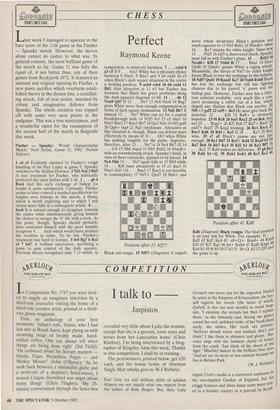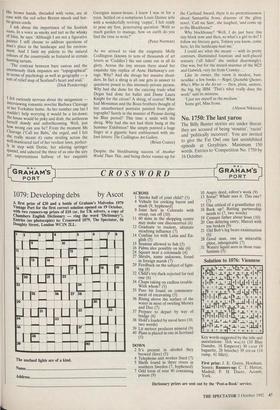I talk to
Jaspistos
In Competition No. 1747 you were invit- ed to supply an imaginary interview by a third-rate journalist visiting the home of a third-rate creative artist, printed in a third- rate glossy magazine.
First, an anthology of your best moments: `Julian's wife, Hattie, who I had last met at Royal Ascot, kept plying us with steaming mugs of freshly made, hand- milled coffee. One can always tell when things are being done right' (Sid Field); 'He enthused about his literary masters Hardy, Elgar, Heraclitus, Pepys — and Mickey Mouse!' (John O'Byrne); 'As he sank back between a minimalist globe and a print-out of a dolphin's brain-waves, I sensed Crispin Stormbird was angry about many things' (Chris Tingley); 'My 25- minute conversation through the letter-box revealed very little about Lydia the woman, except that she is a greenie, loves trees and writes from her Lancashire home' (Chris Kitchen). I'm being interviewed by a biog- rapher of Kingsley Amis this week. Thanks to this competition, I shall be in training.
The prizewinners, printed below, get £20 each, and the bonus bottle of Aberlour Single Malt whisky goes to W. J. Webster.
Earl Grey tea and chiffony drifts of celadon drapery are not exactly what one expects from the author of Baby Burgers. But, then, Lalia
Grossett was never one for the expected. Hailed by some as the Empress of Evisceration, she her- self regards her novels (the latest of which, Eyeball, is due out next month) as social biop- sies. 'I examine the entrails but then I replace them,' as she famously said. Seeing me glance round the cool, polished order of her book-lined study, she smiles. Her teeth are pristine. `Surfaces should entice and mislead, don't you think? I like them to shimmer and gleam.' Her voice sings with the lambent clarity of honey from the comb. 'Just think of the sheen of the tiger.' Mischief dances in the brilliant blue eyes. 'And we are no more or less animals because we
live in Belsize Park.'
(W. J. Webster) Appin Croft's studio is a converted oasthouse in the sun-dappled Garden of England, but his craggy features and silver mane seem more suit- ed to a harsher country or a portrait by Kersh.
His brown hands, threaded with veins, are at ease with the red ochre Breton smock and bot- tle-green cords.
I ask about the importance of his Scottish roots. In a voice as smoky and tart as the whisky of Islay, he says: 'Although I am not a figurative painter I still choose to address questions of man's place in the landscape and his environ- ment. And I limit my palette to the natural colours of the countryside as featured in certain hunting tartans.
The contrast between bare canvas and the enormously thick impastos are "topographical" In terms of psychology as well as geography — a sort of relief map of Scotland's heart and soul.'
(Dick Penderring)
I felt curiously nervous about the assignment interviewing romantic novelist Barbara Cleavage at her Yorkshire home. As her number one fan I couldn't help worrying it would be a let-down: the house would be poky and drab, the authoress herself dowdy and unforthcoming. Well, just how wrong can you be? From the moment Ms Cleavage Nall me Babs,' she urged, and I felt she really meant it) came striding across the well-manicured turf of her verdant lawn, perfect- IY in step with Dottie, her adoring springer spaniel, and ushered the three of us into the airy yet unpretentious hallway of her exquisite
Georgian manor-house, I knew I was in for a treat. Settled on a sumptuous Louis Quinze sofa with a wonderfully reviving `cuppa', I felt ready to pose my first, penetrating question: 'With so much garden to manage, how on earth do you find the time to write?'
(Peter Norman)
As we arrived to visit the enigmatic Molly Codlington (known to tens of thousands of art lovers as 'Coddles') the sun came out in all its glory. Across the tiny stream there stood her exquisite tiny replica of Anne Hathaway's cot- tage. Why? And she shrugs her massive shoul- ders. In fact a shrug is all one gets in answer to questions posed to this intensely private person. Why had she done for the catering trade what Degas had done for ballet and Dame Laura Knight for the circus? A shrug, of course! What had Mossiman and the Roux brothers thought of her unauthorised portraits painted from pho- tographs? Surely in the manner of Picasso during his Blue period? This time a smile with the shrug. Why had she not had them hung at the Summer Exhibition? She simply pointed a huge finger at a gigantic barn emblazoned with six- foot letters: The Codlington Art Gallery.
(Brian Coates)
Despite the blockbusting success of Another World Than This, and being thrice runner-up for the Cartland Award, there is no pretentiousness about Samantha Irons, doyenne of the glitzy novel. `Call me Sam', she laughed, 'and come up to the Blockhouse!'
Why blockhouse? `Well, I do just have this tiny block now and then, so what's a girl to do? I follow my literary guru, Tolstoy you know, come here, let the landscape heal me.'
I could see what she meant — with its pretty contours, illuminated fountain and well-placed statuary ('all fakes!' she smiled disarmingly). One was, but for the muted murmur of the M25 and Gatwick, very far from Crawley ...
Like its owner, the room is modest, busi- nesslike: a few books — Roget, Quotable Quotes, Who's Who in the Jet-set — then, plain, austere, the big, big IBM. 'That's what really does the work!' said its mistress.
`I just see myself as the medium.'
Some girl, Miss Irons. (Alyson Nikiteas)
No. 1750: The last yaroo
The Billy Bunter stories are under threat: they are accused of being `stoutisf , 'racist' and 'politically incorrect'. You are invited to give the Fat Owl one last uninhibited episode at Greyfriars. Maximum 150 words. Entries to 'Competition No. 1750 by 16 October.



















































 Previous page
Previous page